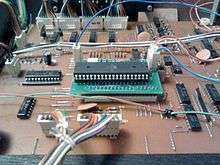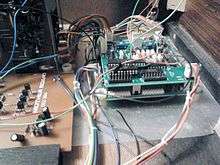Roland Jupiter-4
| Roland Jupiter-4 | |
|---|---|
 Roland Jupiter-4 Compuphonic | |
| Manufacturer | Roland |
| Dates | 1978 - 1981 |
| Price |
US$2,895 UK£1,810 JP¥385,000 |
| Technical specifications | |
| Polyphony | 4 voices |
| Timbrality | Monotimbral |
| Oscillator | 1 VCO + 1 sub-oscillator per voice |
| LFO | 1 triangle/square/sawtooth/reverse sawtooth |
| Synthesis type | Analog Subtractive |
| Filter | 1 resonant lowpass, 1 highpass |
| Attenuator | 2 ADSR |
| Aftertouch expression | No |
| Velocity expression | No |
| Storage memory | 10 presets/8 user patches |
| Effects | chorus |
| Input/output | |
| Keyboard | 49 keys |
| External control | None |
The Roland Jupiter-4 (JP-4) was an analog synthesizer manufactured by the Roland Corporation between 1978 and 1981. It was notable as the company's first self-contained polyphonic synthesizer, and for containing digital control of analog circuits (termed "Compuphonic" by Roland), allowing for such features as programmable memories and voice assignment modes.
Priced at US$2,895, it was cheaper than polyphonic machines from its competitors (such as the Sequential Circuits Prophet-5 and the Oberheim OB-X). However, it did not sell well in comparison. (These poor fortunes were reversed on the release of its successor model in 1981, the popular Jupiter-8.)
Architecture

The Jupiter-4's basic architecture consisted of four identical voice cards, each with a VCO (and sub-oscillator), resonant low pass VCF (Roland BA662 in earlier revisions or IR3109 in later models IC, which could self-oscillate), and variable-gain amplifier (VCA). Modulation included an Attack-Decay-Sustain-Release (ADSR) envelope for the filter, and another for the voltage-control amplifier and a final level output with an overload LED, as well as a separate unmemorized master volume control. The filter ADSR could be inverted, allowing for "upside down" modulation. The final VCA level setting could be memorized in user presets, and was prior to the overall master stereo output volume. The LFO, routable to oscillator pitch, pulse width, filter cutoff and amplifier, was notable for being able to reach audio frequencies, allowing for crude FM and AM synthesis. Those settings were memorized in the user presets but a fully adjustable depth remained independently configurable through the pitch wheel to combinations of VCO, VCF and VCA, as well as a bend range. The VCOs can garner unstable tuning if aging or low-quality electrolytic capacitors are used (two for each voice card). Synthesizer repair shops can replace these tuning capacitors with stable polystyrene capacitors for an instant perfect tune. Individual oscillator card VCO tuning is accessed by four capped holes in the middle of the back of the case, but the unit should be allowed to warm up before adjusting for at least 20 to 40 minutes prior to adjustment.
The Jupiter 4's two most distinctive features were provided by virtue of its "compuphonic" digital control of the four voice cards, made possible by two Intel 8048 chips:[1]
- An arpeggiator, with a choice of up, down, up/down, or random mode. The arpeggiator can be prominently heard in Duran Duran's 1982 hit single "Rio." Switches on the far left select between the internal rate, adjustable, or an external source, such as the clock out of its contemporary, the Roland CR-78—Roland's first programmable analog drum machine. A hold button on the lower front panel allows users to latch or set a constantly running arpeggiator pattern, useful when playing leads on another machine over a JP-4 pattern. Otherwise the arpeggiation only responds when keys, individual or chords, are pressed. This allows for a more fluid and less rigid timing in live situations when playing with others.
- Left-hand modulation from the keyboard is unusual. The polyphonic portamento or glide feature can be used very effectively with in conjunction with the arpeggiator and any preset. An octave down switch by the modulation wheel is also available independent of memorized settings. Unlike Moog or Sequential, the Roland modulation wheel goes left to right, and is spring-loaded. A short spike on top of the spring-loaded modulation wheel allows for an unusual rapid fanning, but risks damage to this out of production part. Knobs allow depth of pitch bend or LFO modulation, in addition to the amounts assigned and memorized. Toggle switches select bend or LFO to the wheel and onto any combination of VCO/VCF/VCA in an unusual selection pattern, all controlled by a single wheel motion.
- Four voice assignment modes, which, as well as simple one-VCO-per-voice polyphony, included the ability to affect four-VCO unison when one key was pressed, two VCOs per voice when two keys were pressed, and one VCO per voice when three or four keys were pressed. This effect can be heard on tracks such as "Seconds" by The Human League and "I Dream of Wires" by Gary Numan.
The final signal path also included a simple high-pass filter and a lush stereo chorus effect based on two, now rare, MN3004 ICs. The chorus circuit board is located underneath the modulation wheel, and has one control: a front button for enabling/disabling the effect. It is lush and wide, supplying a pseudo stereo effect when both outputs are used. This filter, as well as other parts of the machine, also use the BA662 VCA chips, which are also rare. Despite evidence against its alleged sonic magic, the BA662 remains sought by many x0xb0x builders, a superior clone DIY kit of the Roland TB-303. Numerous such chips are used in the early JP-4 circuits and the Roland TB-303.
The Jupiter 4 had ten preset sounds and also featured eight memory locations for user-created patches. Saving to those locations requires two widely separated write record buttons to be held, to protect against accidental writing. A battery located deep between the chorus and power supply preserves the contents of the memory ICs.
A quirk that catches many first-time users is that the lower right preset and user memory buttons disengage most programmable controls to the right of the arpeggiator section when a user or factory preset is used. The controls to the right of the arpeggiator are only live when the yellow manual button is selected. The controls are analog switches and potentiometers, but do not adjust the synth cards directly. They are supplied with hi/low logic voltages or 0–5 volt voltages. Multiplexers and analog to digital converters read the settings, then send them in digital form to the CPU. The CPU then converts these parameters to analog control voltages, and sends them to the analog voice cards and envelope gates. It is a remarkably stable hybrid pioneer with a great analog sound.
Despite not being incredibly popular, it did find its way into the hands of some musicians, most of which were associated with the new wave and synthpop music scenes (see below). Phil Oakey of The Human League eulogized that despite its limitations "the Jupiter 4 will be tatooed on my heart for ever".
Promars
In 1979, Roland released a two-oscillator monophonic synthesizer called the Promars, which is often considered a monophonic version of the Jupiter-4. The Promars did not have the Jupiter-4's arpeggiator or its "ensemble" chorus effect, and reduced the four voice cards to two with basic detune. It had the memory and preset selection buttons above the keyboard, which were less clumsy to use than those on the Jupiter-4. It also had 37 keys, making slightly smaller than the Jupiter-4.
The Promars was used by Depeche Mode (around early-mid 1982), Vangelis (early/mid 1980s), The Enid, Jethro Tull, Landscape and Spandau Ballet (synth lead on 'To Cut a Long Story Short').
Io MIDI retrofit kit


László Kővári aka "Covariance" developed a MIDI kit and CPU replacement for the Jupiter-4. This two-part kit expands the Jupiter-4's patch memory from eight to sixty-four and also allows recalled patches to be dynamically modified (the original 8048 disallows editing once the patch has been saved). In addition to MIDI all sliders and switches can receive MIDI control messages, the arpeggio can be synced to the MIDI clock as well. A second LFO was also added which is even faster than the Jupiter-4's original LFO.
The retrofit kit was named Io to reference to Jupiter's moon, and Input-Output.[2]
Notable musicians/bands known to have used the Jupiter-4
- Michael Jackson (Thriller)
- Covenant, using (still to this day) a JP-4 as well as a Promars.
- Devo
- Late of the Pier
- Duran Duran (Duran Duran, Rio, Medazzaland)
- Wolf Parade
- Juicy Audio Productions (Shekhar Raj Dhain) - through a filterbank
- The Unicorns
- Gary Numan (Telekon, Dance)
- Men at Work (Business as usual, Cargo)
- Jon & Vangelis (Short Stories, The Friends of Mr Cairo, Private Collection)
- Tangerine Dream (Tangram)
- Meat Beat Manifesto
- Paul Davis Used in his self-titled 1980 LP
- Stevie Wonder
- The Cars
- Thomas Dolby (The Golden Age of Wireless)
- Level 42 ("Last Chance" from The Pursuit of Accidents)
- David Bowie
- The Human League (Reproduction, Travelogue, Dare)
- Heaven 17 (Penthouse and Pavement)
- John Foxx
- Isao Tomita
- Simple Minds (Empires and Dance, Sons and Fascination/Sister Feelings Call, New Gold Dream (81–82–83–84))
- The Moog Cookbook
- Vince Clarke
- Depeche Mode (Speak & Spell)
- Yazoo (Upstairs at Eric's)
- BT
- Spandau Ballet (Journeys to Glory)
- Tangerine Dream
- Vangelis
- Whodini - well known for the fast arpegiator lead on "Magic's Wand" courtesy of Thomas Dolby
- Saint Etienne
- Soft Cell
- Le Le
- Peter Howell
- The Spoons
See also
References
- ↑ Gordon Reid (November 2004). "The History Of Roland, Part 1: 1930-1978". The History Of Roland. Sound On Sound Magazine. Retrieved 29 November 2010.
- ↑ Covariance (2010). "What is Io". MIDIpolis FAQ. MIDIpolis. Retrieved 9 December 2012.
External links
- Synthmuseum.com's page on the Jupiter-4
- Thomas Kahn's DIY CV/Gate interface for the Roland Jupiter 4
- unusual but effective usage example in a track, with lfo pitch modulation, as a mid part, which can be clearly heard from 3 minutes onward